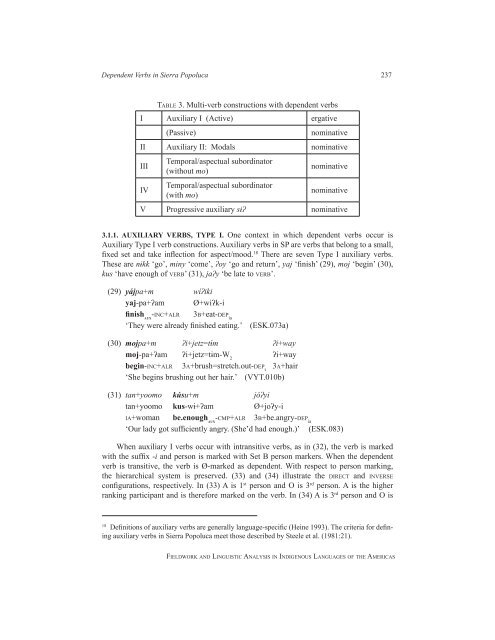Fieldwork and Linguistic Analysis in Indigenous ... - ScholarSpace
Fieldwork and Linguistic Analysis in Indigenous ... - ScholarSpace
Fieldwork and Linguistic Analysis in Indigenous ... - ScholarSpace
You also want an ePaper? Increase the reach of your titles
YUMPU automatically turns print PDFs into web optimized ePapers that Google loves.
Dependent Verbs <strong>in</strong> Sierra Popoluca 237<br />
table 3. Multi-verb constructions with dependent verbs<br />
I Auxiliary I (Active) ergative<br />
(Passive) nom<strong>in</strong>ative<br />
II Auxiliary II: Modals nom<strong>in</strong>ative<br />
III<br />
IV<br />
Temporal/aspectual subord<strong>in</strong>ator<br />
(without mo)<br />
Temporal/aspectual subord<strong>in</strong>ator<br />
(with mo)<br />
nom<strong>in</strong>ative<br />
nom<strong>in</strong>ative<br />
V Progressive auxiliary sɨʔ nom<strong>in</strong>ative<br />
3.1.1. AUXILIARY VERBS, TYPE I. One context <strong>in</strong> which dependent verbs occur is<br />
Auxiliary Type I verb constructions. Auxiliary verbs <strong>in</strong> SP are verbs that belong to a small,<br />
fixed set <strong>and</strong> take <strong>in</strong>flection for aspect/mood. 18 There are seven Type I auxiliary verbs.<br />
These are nɨkk ‘go’, m<strong>in</strong>y ‘come’, ʔoy ‘go <strong>and</strong> return’, yaj ‘f<strong>in</strong>ish’ (29), moj ‘beg<strong>in</strong>’ (30),<br />
kus ‘have enough of verb’ (31), jaʔy ‘be late to verb’.<br />
(29) yájpa+m wíʔiki<br />
yaj-pa+ʔam Ø+wiʔk-i<br />
f<strong>in</strong>ish AUX -<strong>in</strong>c+alr 3b+eat-deP ia<br />
‘They were already f<strong>in</strong>ished eat<strong>in</strong>g.’ (ESK.073a)<br />
(30) mojpa+m ʔi+jetz=tɨ́m ʔi+way<br />
moj-pa+ʔam ʔi+jetz=tɨm-W 2 ʔi+way<br />
beg<strong>in</strong>-<strong>in</strong>c+alr 3a+brush=stretch.out-deP t 3a+hair<br />
‘She beg<strong>in</strong>s brush<strong>in</strong>g out her hair.’ (VYT.010b)<br />
(31) tan+yoomo kúsu+m jóʔyi<br />
tan+yoomo kus-wɨ+ʔam Ø+joʔy-i<br />
ia+woman be.enough AUX -cmP+alr 3b+be.angry-deP ia<br />
‘Our lady got sufficiently angry. (She’d had enough.)’ (ESK.083)<br />
When auxiliary I verbs occur with <strong>in</strong>transitive verbs, as <strong>in</strong> (32), the verb is marked<br />
with the suffix -i <strong>and</strong> person is marked with Set B person markers. When the dependent<br />
verb is transitive, the verb is Ø-marked as dependent. With respect to person mark<strong>in</strong>g,<br />
the hierarchical system is preserved. (33) <strong>and</strong> (34) illustrate the direct <strong>and</strong> <strong>in</strong>verse<br />
configurations, respectively. In (33) A is 1 st person <strong>and</strong> O is 3 rd person. A is the higher<br />
rank<strong>in</strong>g participant <strong>and</strong> is therefore marked on the verb. In (34) A is 3 rd person <strong>and</strong> O is<br />
18 Def<strong>in</strong>itions of auxiliary verbs are generally language-specific (He<strong>in</strong>e 1993). The criteria for def<strong>in</strong><strong>in</strong>g<br />
auxiliary verbs <strong>in</strong> Sierra Popoluca meet those described by Steele et al. (1981:21).<br />
fieldwork <strong>and</strong> l<strong>in</strong>guistic analysis <strong>in</strong> <strong>in</strong>digenous languages of the americas

















